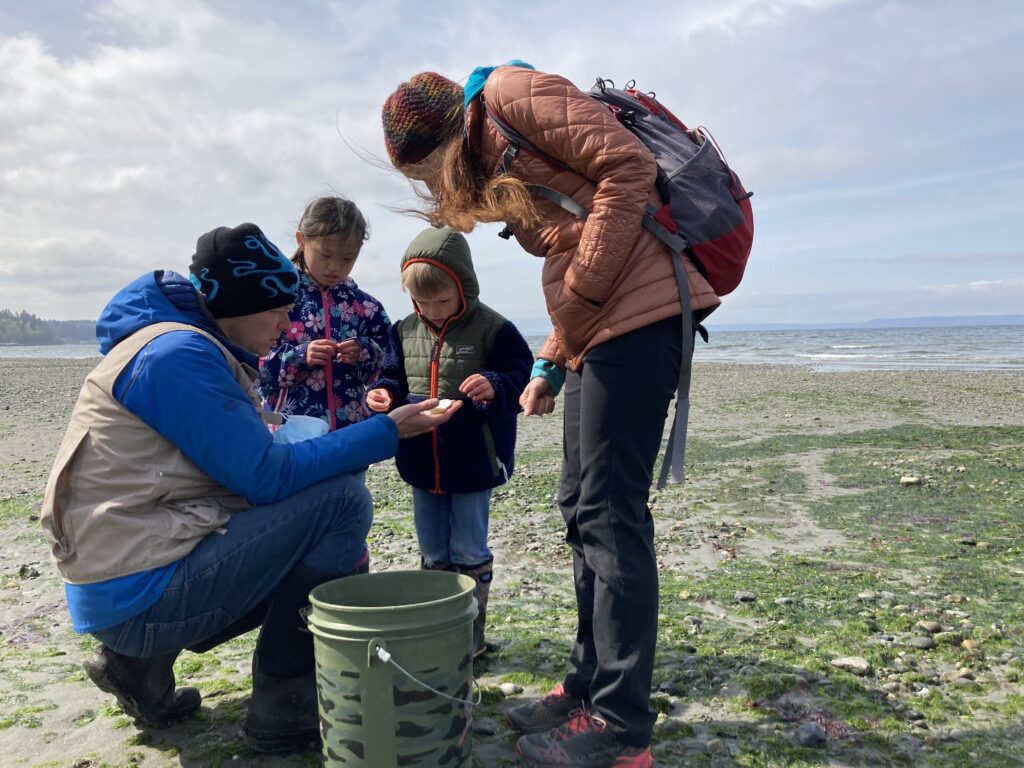A new program will enable anyone who walks the shorelines of Puget Sound to identify one of Washington state’s most concerning invasive species: European green crab.
In response to this shore crab’s booming population, Washington State University Extension and Washington Sea Grant outreach specialists are rolling out the Molt Search program in May.
WSU Extension and Sea Grant are recruiting volunteers for training to support early detection efforts along Washington’s inland shorelines by searching for European green crab shells and reporting evidence of their presence to managers.
The state of Washington deployed emergency measures in 2022 to slow the crab’s spread and protect shorelines from harmful impacts. Green crab eat or compete with a wide range of native species, including juvenile Dungeness crab and littleneck clams. They also destroy seagrass habitats important to salmon.
Molt Search will train participants to systematically search beaches for molts, the exoskeletons the crabs shed, which can wash up on shorelines before European green crabs can be detected with traps.

“Green crabs tuck under logs, rocks and vegetation, making them difficult to spot,” said Bob Simmons, Olympic region water resources specialist with WSU Extension. “They can hide in the shallows of mudflats or in protected estuaries and pocket marshes, areas very difficult to safely access. Finding molts is easier since they wash to the upper beach with high tides.”
European green crabs grow up to four inches wide, much smaller than the well-known Dungeness crab. The name can be misleading: coloring ranges from a tinged or mottled green to orange and dark red. Their trapezoidal body is distinguished from native species by having five “marginal teeth,” a zigzag of five distinct spines that frame the eyes on either side of their shell.
Further identification graphics and other resources are available through the Washington Department of Fish and Wildlife species webpage.
Once European green crabs are found in an area, Washington Department of Fish and Wildlife, Native American tribes, shellfish growers, and other partners deploy hundreds of traps.
For Emily Grason, a marine ecologist at Washington Sea Grant, more volunteers scouting the shoreline means a quicker trapping response when green crabs are detected.
“If we don’t find new populations until they are already abundant and widespread, we miss the best — and maybe the only — chance we might get to protect local habitats, species and economies,” she said. “Green crab control is about early detection, finding populations within the first generations of their arrival at a new site, and aggressively trapping down populations even if they are still small and hard to find.”
Thousands of miles of shoreline to cover
The Washington portion of the Salish Sea has more than 2,000 miles of shoreline, stretching from Neah Bay to Nisqually Reach, back up to Semiahmoo Bay, and including the iconic San Juan Islands.
European green crabs were first detected along Washington’s inland shorelines of Puget Sound in 2016. With a few exceptions, they are still extremely rare or undetectable across most of the region.

Current monitoring efforts rely primarily on baited traps, but trapping has limitations. Grason leads Washington Sea Grant’s Crab Team, which coordinates a network of 56 sites spanning Puget Sound shorelines and has conducted early detection trapping since 2015.
“Trapping is time-consuming, labor-intensive, and logistically challenging,” she said. “Even with so many sites and volunteers, we can’t cover all of the shorelines where green crab could be found.”
Molt Search will enable volunteers to search much more of Puget Sound’s shorelines. Participants will submit survey reports via the MyCoast mobile app, enabling Washington Department of Fish and Wildlife staff and partners to identify and target gaps in trapping efforts.
WSU Extension and Sea Grant are partnering with local organizations to spearhead trainings in each of the 12 Puget Sound counties, empowering volunteers to begin scouting scenic and important locales.
“The goal is to train more and more volunteers going forward,” said Simmons.
Cheryl Lovato Niles, water resources educator with WSU Whatcom County Extension, sees the spread of European green crab as a call to action.
“The green crab threatens a number of iconic Pacific Northwest species,” she said. “By training volunteers to identify and report sightings, we’re utilizing WSU’s strengths in community partnerships and action, volunteer recruitment, and training experience to help make this a success.”

The first training will be held May 10 in Kitsap County. Additional trainings are scheduled throughout May and early June.
Jonathan Robinson, lead coordinator of the WSU Extension Beach Watchers program in Snohomish County, will also train volunteers beginning in May.
“What is so great about this project is anyone can do it and make an impact,” Robinson said.





